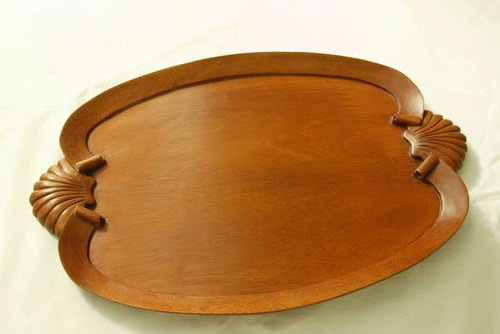
Ribbon and Scroll Tray
In 1976 I was fortunate to come across a wonderful book that influenced my work greatly. I say that I am a "self-taught" wood worker but everyone is standing on the shoulders of those who went before. There is nothing new under the sun and everything has been done or tried in the past. We are so fortunate that some have bothered to take the pains to document what they have done for the benefit of others.
Such an individual was Andy Marlowe. He was a cabinetmaker in York, Pennsylvania, who has since passed on. He wrote Fine Furniture for the Amateur Cabinetmaker. The book is long out of print but you might be able to find it on sites that sell used books. What I admired about the book is Mr. Marlowe’s fine taste and his ability to take you step by step through increasingly more demanding projects until you are making museum quality reproductions.
I began with the simple baroque letter opener featured in the Accessories section of this site. My latest was the oval, ball and claw, Philadelphia, Chippendale stool in the Furniture section, the original of which is in the Winterthur Museum in Delaware.
This baroque, ribbon and scroll, shell-handled, serving tray is one of the early intermediate projects in Mr. Marlowe’s fine book. It is made of mahogany.
Mahogany was a favorite wood of the 18th century wood worker, as it has such an even texture and carves quite easily. This is important when doing rather intricate designs in wood.
The tray is carved from solid wood and none of the molding or devices are applied. It is composed of two boards edge-glued side by side. It is very hard to find a single plank of mahogany as wide as this tray, and if you did you probably could not afford it.
I made several of these trays and used various finishing techniques on these trays starting with French polish but finally settling on Danish oil and wax.
It is more a looking tray than one on which one serves food. It is saved for special occasions and looks great on a mantel or other place of honor. The design is just so pleasing that it never fails to invoke feelings of admiration.
In this day and age when it is so chic to be “original” even to the point of being outlandish, I take deep satisfaction in the perfection of this eighteenth century design. I much rather have a beautiful reproduction than an ugly original. Yet, this is just my personal bias.
